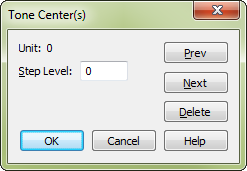

(You clicked Next twice because this dialog box doesn’t appear if Linear Key Format 0 or 1 is selected; these key formats are predefined as the standard major and minor key systems, respectively.)
This dialog box concerns the creation of linear key formats and nonlinear key signatures; see Nonstandard Key Signature dialog box for a more complete discussion. In brief, Finale lets you create nonstandard key systems and key signatures, based on scales with any number of steps, and with accidentals placed in any order you want.
In this dialog box, you specify the relationship between the number of accidentals in a key signature and the tone center of the key so defined. (You can think of the tone center as the root scale degree. You establish this relationship for every key in your linear key format. (In the case of nonlinear key signatures, there’s no particular relationship between one and another; each nonlinear key signature is a special situation.)
You’ll see the effects of these settings any time Finale needs to associate the notes in your piece to the "root" of the scale (the tone center). For example, if these relationships haven’t been constructed properly, you may notice strange effects when you create chord symbols or perform transpositions.
This indicator identifies the Unit, or accidental, for which you’re changing the relative tone center. In the standard key system, if the Unit is 3 (signifying the appearance of the third sharp), you’d set the tone center to be A. Click the Previous and Next buttons at the bottom of the dialog box to change the Unit indicator.
For example, in the traditional key system, Unit –1 refers to the first flat to appear—B flat (in the key of F, as it happens). For the key identified by the appearance of the B flat, you’d specify a Step Level of 3, because the Tone Center (or key) is F, which is three diatonic steps above C (remember, C is considered scale degree zero).
See also:
|
Finale User Manual Home
|

|